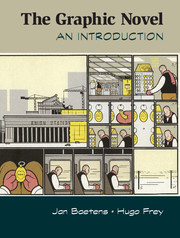Book contents
- Frontmatter
- Contents
- List of illustrations
- Acknowledgments
- 1 Introduction: The Graphic Novel, a Special Type of Comics
- Part One Historical Context
- Part Two Forms
- 5 Understanding Panel and Page Layouts
- 6 Drawing and Style, Word and Image
- 7 The Graphic Novel as a Specific Form of Storytelling
- Part Three Themes
- Notes
- Index
6 - Drawing and Style, Word and Image
Published online by Cambridge University Press: 05 October 2014
- Frontmatter
- Contents
- List of illustrations
- Acknowledgments
- 1 Introduction: The Graphic Novel, a Special Type of Comics
- Part One Historical Context
- Part Two Forms
- 5 Understanding Panel and Page Layouts
- 6 Drawing and Style, Word and Image
- 7 The Graphic Novel as a Specific Form of Storytelling
- Part Three Themes
- Notes
- Index
Summary
Having discussed panel and page layout in the preceding chapter, we next turn to matters of style and the issues that graphic novels present because of their hybrid nature of combing words and images. One needs new critical tools to better understand graphic novels, and this book offers a series of summations to assist students theorize works that, at present, most of them read without reference to an explicit mode or method.
From style to graphiation
Drawing and style is an obvious, although sometimes neglected, facet of all graphic novels. Moreover, style is, in whatever context one studies it, a very complex notion. First, even if one reduces, for simplicity’s sake, style to visual style – or more specifically to drawing style, leaving aside narrative style, for instance – the number of questions remains very high. For example, when introducing the McSweeney’s issue on graphic narratives, Chris Ware writes:
The possible vocabulary of comics is, by definition, unlimited, the tactility of an experience told in pictures outside the boundaries of words, and the rhythm of how these drawings “feel” when read is where the real art resides. All cartoonists have a signature “style” that exists beyond the look of their art or the quality of their writing – a sense of experience, a feeling of how they see the world – as expressed in how their characters move, how time is sculpted. Comics are an art of pure composition, carefully constructed like music, but constructed into a whole architecture, a page-by-page pattern, brought to life and “performed” by the reader – a colorful piece of sheet music waiting to be read.
It is no doubt complex, too, because style is also often assimilated to one single aspect: the almost biological expression of the author, whose body is made manifest through his or her personal style.
- Type
- Chapter
- Information
- The Graphic NovelAn Introduction, pp. 134 - 161Publisher: Cambridge University PressPrint publication year: 2014



